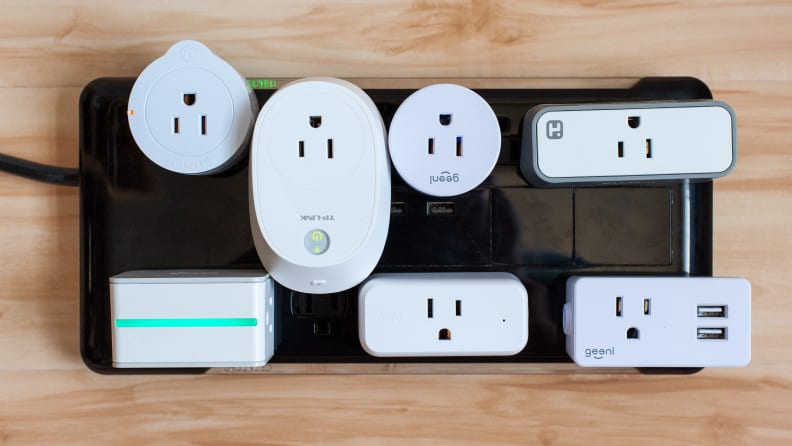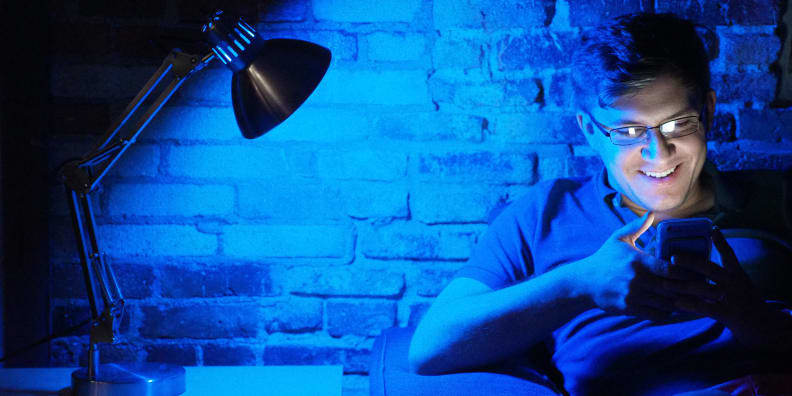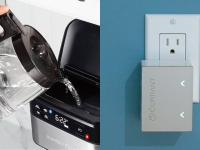 — Recommendations are independently chosen by Reviewed’s editors. Purchases you make through our links may earn us a commission.
— Recommendations are independently chosen by Reviewed’s editors. Purchases you make through our links may earn us a commission.From video doorbells that can tell you who’s at the door to smart thermostats that intuitively create temperature schedules based on your habits, when it comes to creating your own smart home the possibilities are (just about) endless.
However, in the early stages of constructing your smart home, you may feel confused and overwhelmed by the sheer variety of smart home tech available. Which smart home devices are best for beginners? Which smart assistant should you choose? And are smart speakers really listening in on private conversations? There’s a lot of information swirling out there, but our handy guide to creating a smart home setup lays a solid foundation for bringing your home into the 21st century.
Picking a smart assistant
Amazon Alexa and Google Assistant are the two most popular smart assistants and each works with most smart home gadgets, while other devices are meant only for use with Apple HomeKit, Bixby, or Microsoft Cortana. If you’re unsure about compatibility, check the product’s packaging or description for specific details.
However, unless you’re dead set on running an Apple HomeKit, Bixby, or Microsoft Cortana smart home ecosystem, we recommend using Google Assistant or Alexa for the best experience.
Overall, we’ve found that Google Assistant is easier to interact with, especially since Google can handle up to three commands at once. That said, while Google Assistant integrates with more than 30,000 devices, Alexa wins the compatibility battle, working with 85,000 devices like smart switches, plugs, and much more.
Choosing a smart speaker

A smart speaker acts as a central hub to control your smart home devices.
Alexa and Google Assistant can be accessed via their respective apps on your smartphone or tablet, but we recommend investing in a smart speaker for optimum control over your new smart home. Most smart speakers are built with multiple far-field microphones to hear you from the next room.
While we love most Amazon Echo speakers, the Echo (third-generation) provides awesome sound quality given its compact size, and it offers a desirable blend of quality performance and value.
For Google Assistant-controlled smart homes, we think the Nest Mini is a good place to start for beginners. The Mini is easy to set up, automatically adjusts the volume of the speaker’s response when there’s too much noise in the background, and responds quickly to voice commands. It’s slightly larger than a hockey puck and comes with a built-in wall mount on the backside for easy hanging.
Smart home gadgets to get you started
Smart plugs

These compact devices plug into traditional wall sockets, upgrading them to smart home devices with remote control, scheduling, and power usage monitoring via smartphone apps.
Smart plugs are one of the easiest smart home gadgets you can use, which is why we think this is the perfect place to start building your smart home. A smart plug converts basic small appliances and electronics into devices that can be controlled remotely or via your smart assistant. The plug inserts into a standard electrical outlet and comes with one (sometimes two) front or side facing outlets that can be controlled independently.
Some smart plugs, like the Currant WiFi Smart Outlet, offer real-time energy monitoring, multiple outlets on one plug, and recommend on/off schedules based on your usage. Other smart plugs, like the Eufy Smart Plug Mini, still offer a strong and reliable connection like Currant, but lack energy monitoring capabilities. And, of course, how much you want to spend will be a factor.
You’ll also want to be mindful of the size and shape of the smart plug you purchase. A bulky plug like the TP-Link Smart WiFi Plug with Energy Monitoring will block the second wall outlet.
Smart lighting

Across the board, Philips Hue LED lights topped all of our tests thanks to an easy setup, a robust suite of features, and an intuitive app.
While smart plugs can be used to control "dumb" lights like lamps, smart bulbs and smart switches are a better option for light fixtures. When choosing your smart lighting option, here are a few tip to keep in mind:
Smart bulbs offer an attractive starting point for those who want to ease their way into smart home lighting slowly. Smart bulbs include an array of colors and are good for renters or those who don't want to fiddle with electrical wires. All you need to do is screw the smart bulb into the light socket and follow the setup instructions in the bulb’s app. On the other hand, replacing every bulb can be costly.
Smart switches work with regular bulbs—and while you won’t get you the same bells and whistles as you would with a multi-color smart bulb, smart switches are much easier to use. Installing one smart switch can control all of the light bulbs in one fixture, saving you from purchasing multiple bulbs.
For dimmable lights, an in-wall smart dimmer switch gives you total control over the brightness of multiple bulbs in a light fixture.
The switch for a light with smart bulbs needs to be in the “on” position in order to be controlled via an app or with a smart assistant. However, the reverse is true for smart switches and dimmers, which can be controlled remotely even if the physical switch is off.
While the Philips Hue White and Color Smart Light Starter Kit contains the best smart bulbs we’ve tested, it requires a hub and that's an extra expense to take on before you've truly committed to a smart lighting set up. For those reasons, we'd point you in the direction of the eufy Lumos Smart Bulbs, which don't require a hub and have a quick response time.
Bottom line: if you’re jonesing to convert all your lights at once, smart switches are likely the most cost effective way to go (and you don’t need a professional electrician to install them). But, if you’re just looking to test the waters, smart bulbs are a quick and easy introduction into a world of smart lighting schedules, timers, and more.
Get the Philips Hue White and Color Smart Light Starter Kit on Amazon for $179.99
Get the Leviton Decora Smart Switch (WiFi) on Amazon for $53.65
Smart doorbells

The Google Nest Hello is an easy-to-use doorbell that can recognize familiar faces, sends immediate alerts over data and WiFi, and never lost its connection during our tests.
Smart doorbell cameras have exploded in popularity over the last few years—they are a perfect addition to your budding smart home. I’ve installed lots of smart doorbells in my lifetime and it’s as easy as connecting a few low-voltage wires.
We’ve been testing smart doorbells for years, and the Google Nest Hello is the best you can buy. Not only is it a cinch to get up and running; it’s reliable, accurate, and easy enough for home security DIY’ers to install without help from a pro.
Most smart doorbells offer live video feed of the area outside of your front door, two-way audio to communicate with visitors, and timely alerts that are sent to your smartphone even when you’re not home. However, popular smart home brands like Ring and Nest require paid subscription plans if you want to get the most out of your doorbell. It’s usually a minimal monthly cost, but it’s something to consider when investing in a smart doorbell.
If you’re looking for a doorbell camera that doesn't require a paid subscription to store footage, we recommend the Eufy Video Doorbell. It’s fast, quick to install, and a pleasure to use for an affordable price.
The majority of smart video doorbells work with Alexa and Google Assistant. If you’ve got a smart speaker, you can even sync your doorbell to make announcements when someone rings it.
Other smart home gadgets for beginners
There’s more to a smart home than smart lights, plugs, and doorbells, but those categories are easy jumping-off points into a more connected home.
As you build out your smart home, there are plenty of other smart home devices to keep in mind, like indoor security cameras, pet cameras, water leak detectors and more.
Smart thermostats are also an excellent addition, though they can sometimes be a bit more complicated to set up. If you're game to go deeper, this guide should help you get a smart thermostat up and running.
Is your internet up to snuff?
All smart home devices require a stable internet connection to function properly. Some homes may have areas where WiFi can be patchy, working better ins some areas of your home than others. With a mesh WiFi router, you can solve your spotty internet woes and help your smart home stay connected.
One final note about your internet and smart home devices: WiFi routers typically emit two connection types: 2.4 GHz and 5 GHz. A good majority of smart home devices rely on a 2.4 GHz connection, but you may find your most commonly-used devices, like smartphones and tablets, are connected to the 5 GHz. This can cause some problems when you begin connecting your new smart home gadgets to your home’s WiFi network.
To avoid this issue, make sure that whatever device (smartphone or tablet) you’re using to set up your new smart home swag is connected to the 2.4GHz frequency.
Smart home privacy concerns

A red light ring means the Echo's microphones are turned off, and Alexa can't hear your conversations.
Anytime you invite a smart device into your home, there’s a chance you’re forgoing at least some of your personal privacy.
You’ve probably caught wind of the headlines when major tech companies like Apple, Amazon, and Google have addressed previous privacy concerns over using audio recordings as part of their respective voice-assistant quality evaluation processes.
Each time you say "Alexa" or “Hey Google,” (or whatever your wake word of choice happens to be for your smart speaker), there’s a chance someone may review the audio, unless you adjust your privacy settings. However, the wake word (“Alexa” or “Hey Google”) and the command or question that follows are all that’s being recorded.
So, what does it mean for you? Your conversations won’t automatically be stored away for review unless you give your smart speaker permission to do so. During the set up of your smart speaker, make sure to poke around the settings and adjust the privacy controls to your liking.
A few other tips for protecting your smart home privacy:
Most smart speakers have a mute button for the mic, and there’s a way to shut off the camera on most smart display screens (like the Echo Show or Nest Hub).
You can also get rid of your interactions with Google Assistant and delete your Alexa recordings.
Create a unique password each time you set up a new smart home device—and don’t make it something that’s easy to guess, like family names and important dates. The stronger your password, the less likely a hacker will gain entry to your account.
Related content
-

-

The Best Smart Home Devices for Apartments of 2020best-right-now



